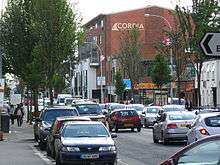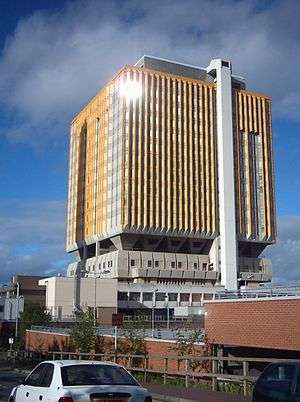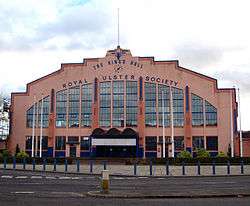Lisburn Road
Lisburn Road is a main arterial route linking Belfast and Lisburn, Northern Ireland.

The Lisburn Road is now an extension of the "Golden Mile" with many shops, boutiques, wine bars, restaurants and coffee houses. The road runs almost parallel to the Malone Road, the two being joined by many side roads. It is a busy traffic route without much strong architectural character. Most of the housing is made up of red-brick terraces, some with alterations. Some buildings along the road, however, are considered to be architecturally important and interesting.[1]
Lisburn Road itself begins at the nearby Bradbury Place and runs to Balmoral Avenue, beyond which it becomes Upper Lisburn Road. The Upper Lisburn Road extends south to reach Finaghy, at which point it becomes Kingsway and then in Dunmurry it becomes Queensway, before finally becoming the Belfast Road in Lisburn.
History
The first record of the development of the Lisburn Road was when a property developer offered land for development 'West of the Lisburn Road' on 6 April 1813. His advert was placed in The News Letter on that date. The track that initially existed here developed and expanded, until pressure grew for a faster turnpike road to Dublin, to avoid the Malone Road hills and valleys. During 1817–1819 this road improvement scheme was implemented. The post office and toll booth stood, conveniently, at Shaftesbury Square, and presumably served both turnpike roads. At the top of Tate's Avenue, on the Lisburn Road side of the junction a second booth was in existence in 1857.[2] One year later the toll business was abandoned, as the trains had taken over. Shopping habits have changed and the shopping population has moved from Shaftesbury Square,[3] along the Lisburn Road.

Lisburn Road attracted shops and the nearby Malone Road was left residential.[4] Queen's University is nearby, and there are a high number of expensive shops and restaurants. The Belfast City Hospital and the Queen's University Medical Biological Centre are also located on the road.
Racist attacks
In June 2009, having had their windows broken and deaths threats made against them, twenty Romanian Romani families were ejected from their homes in Lisburn Road. Up to 115 people, including women and children, were forced to seek refuge in a local church hall after being attacked. They were later moved by the authorities to a safer location.[5][6][7] As a result of petty thefts gypsies were told to leave, they spent one night at QUB Elms Village at a cost of 40 pounds per room. Following the arrest of three local youths in relation to the attacks, the church where the Romani people had been given shelter was badly vandalised.[8] Niall Colton and Kevin Briggs, who both attended QUB at the time of the attack, received police cautions after admitting vandalism of the Church. Police however stated that the vandalism was not racially motivated.[9]
Landmarks

Notable landmarks along Lisburn Road include:
- Drumglass Park
- Belfast City Hospital
- The Samaritan Hospital, Belfast
- Methodist College Belfast (which also fronts the Malone Road)
- Belfast Chinese Christian Church
- Windsor Park football ground
- King's Hall, Belfast (Exhibition and Concert Venue)
- Belfast Hypnotherapy Centre
Wildlife
A sparrowhawk (Accipiter nisus) catching a sparrow (Passer domesticus) has been recorded from the Lisburn Road.[16]
Railway stations
References
- Larmour, P. 1991. "The Architectural Heritage of Malone and Stranmillis." Ulster Architectural Heritage Society.
- OS map of that date
- Weatherall, N. 2002. South Belfast Terrace and Villa. ISBN 1 900935287
- Weatherall. 2002. South Belfast Terrace and Villa. Cottage Publications. ISBN 1-900935-28-7
- "Racist attacks on Roma are latest low in North's intolerant history". irishtimes.com. 18 June 2009. Retrieved 18 June 2009.
- Morrison, Peter; Lawless; Selva, Meera; Saad, Nardine; Wolfe Murray, Alina (17 June 2009). "Romanian Gypsies attacked in NIreland". guardian.co.uk. Associated Press. Retrieved 13 August 2012.
- "Protest held over racist attacks". BBC News. 20 June 2009. Retrieved 20 June 2009.
- McDonald, Henry (23 June 2009). "Vandals attack Belfast church that sheltered Romanian victims of racism". London: guardian.co.uk. Retrieved 23 June 2006.
- "Church vandal students cautioned". Belfast: bbc.co.uk. 23 November 2009. Retrieved 23 November 2009.
- http://www.windsorpresbyterian.com
- "Church Gazetteer: St Nicholas Church". www.stnicholascenter.org. Retrieved 13 August 2012.
- http://www.stthomas.connor.anglican.org
- Lamour, P. 1987. Belfast An Illustrated Architectural Guide. Friar's Bush Press, ISBN 0-946872-10-4.
- http://www.ulsterville.org Archived 9 May 2008 at the Wayback Machine
- "Archived copy". Archived from the original on 12 February 2007. Retrieved 29 April 2009.CS1 maint: archived copy as title (link)
- Scott, R. 2004. Wild Belfast on safari in the city. The Blackstaff Press. ISBN 0-85640-762-3
External links
| Wikimedia Commons has media related to Lisburn Road. |
